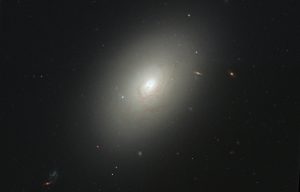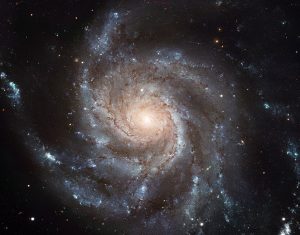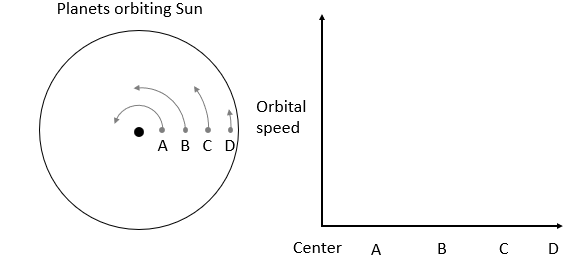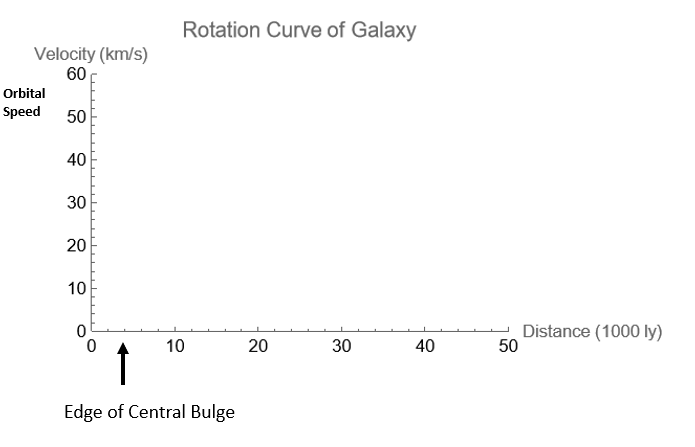7 Chapter 7 – What’s a galaxy?
OpenStax Astronomy Chapter 26: Galaxies
OpenStax Astronomy Chapter 27: Active Galaxies, Quasars, and Supermassive Black Holes
Types of Galaxies
I. and The
A. : large collection of
1. together by
B. Galaxy contains about
1. About light-years across
C. : full expanse of and
D. There are of in the universe arranged in clusters and
II. Galaxy
A. galaxies (S): and thin , with and
1. Look if face on but flat if on
2. Also known as galaxies
B. galaxies (E): or football-shaped from any
1. Further classified by how elliptical or
a. E0: near to E7: very elliptical
C. galaxies (Irr): spiral or elliptical, defined
D. : appear to be a between spiral and elliptical
1. Have a but
III. Two of
A. Spirals (S): or oval central bulge
B. Spirals (SB): central bulge is shaped
C. Further classified by how the is and how the are
1. Sa/SBa: center, arms
2. Sc/SBc: dimmer center, arms
D. : developed by Edwin Hubble (1930s) as a way to galaxy types
1. Ellipticals on , more elongated as go up (E0 – E7)
2. S0 at
3. Plain and Barred make up the of the fork going up from Sa to Sc
4. This is an path
IV. between Spirals and Ellipticals
A. Contain different types of :
1. Mostly gas in
2. Mostly gas in , also contain a lot of
B. Formation of :
1. star formation in or S0 galaxies, nothing to form from
2. are forming in galaxies from gas and dust
C. Different :
1. : because contains only low-mass red stars
a. Not forming any new stars and high-mass stars are already
2. : because always forming stars
a. Light from young O-type blue stars
Which of these is not a characteristic of elliptical galaxies?
A. Mostly hot gas
B. Oval shape
C. New star formation
D. Mostly red stars
A galaxy that appears to have mostly red stars, likely:
A. Will have blue stars in the future
B. Had blue stars but they have evolved and died
C. Never contained enough gas to have blue stars develop
D. Has blue stars that are being blocked by dust
Dark Matter
Evidence for Dark Matter:
V. Spiral Galaxy
A. of stars around a galaxy depend on
1. The strength of gravity on amount of inside their and from that mass
2. mass = star will orbit at a speed
3. More = speed
B. Center of galaxy is , so looks like (stars) in the of the galaxy
C. So, orbital or speeds should as you go out from center
D. , when from center to edge of galaxy this does !
1. Plot of orbital speeds versus distance from center called
E. Rotation curves are : stay the as you go out from center
F. This that luminous matter produce all the in a galaxy
G. There must be an of that does
1. Called
How do we know that galaxies are mostly dark matter?
A. Flat rotation curves
B. We see dark lanes in spiral arms
C. Most galaxies have supermassive black holes
VI.
A. Mostly in the parts of a galaxy and beyond in a
B. dominates galaxies as well
1. Use to trace out beyond
2. Where there is hot gas there must be to hold onto it
C. About of the of a typical (S & E) is dark matter
D. Two of Dark Matter:
1. : compact objects
a. Examples:
2. : Weakly massive
E. Used Gravitational to look for , but don’t see nearly
F. Physics like particle colliders searching for , but them
G. ideas: change theories of particle physics or gravity
In a spiral galaxy, the orbital speeds of stars far from the galaxy’s center as the distance from the center increases.
A. Increase
B. Decrease
C. Are approximately the same
D. The answer changes depending on the galaxy.
Quasars, AGN, and Supermassive Black Holes
VII.
A. Quasar: “ source”: looks like a small bright star with radio telescope
B. quasar is lightyears away
1. This also means quasars have occurred in
C. equals about a to a thousand trillion Suns!
1. Equal to luminosity of entire
What are Quasars?
VIII. AGN:
A. Quasars are AGN
B. In general, AGN are centers of spiral galaxies
C. Produce of from radio to
D. swirls around at high
1. to tens of thousands of miles per second
E. Light rapidly (in day or two), so must be (size of solar system)
F. Also produce of material shooting out from galaxy center
What is a quasar?
A. A bright AGN
B. An elliptical galaxy
C. A neutron star
D. A regular star
IX. What AGN?
A. : a central (SMBH) with an
1. Unifies of all AGN
B. Supermassive: of times the mass of the Sun
C. of material shoot out from the of the SMBH
D. A (torus) of surrounds the accretion disk
E. we see comes from on SMBH from
X.
A. Probably exist at the of galaxies
1. Including
B. normal do have or an accretion around their SMBH
C. So, most galaxies have for , they are active
1. Material in the is an AGN’s source of
2. Without material to feed AGN,
3. SMBH can only be found by effects
What happens to active galaxies when their AGNs run out of fuel?
A. The black holes powering them collapse even further.
B. They simply become normal galaxies.
C. They slowly dissipate into clouds of gas and dust.
D. They eventually pull in material from farther out, starting the AGN process all over again.
Tutorial Activity – Galaxies
“Elementary Astronomy Worksheet Handout 21: Milky Way Galaxy, Galaxies” (modified by Kaisa E. Young) by Catherine Whiting via OER Commons, licensed under CC BY 4.0, https://oercommons.org/courses/elementary-astronomy-worksheets

Figure 1: NGC 4150 by NASA, ESA, R.M. Crockett (University of Oxford, U.K.), S. Kaviraj (Imperial College London and University of Oxford, U.K.), J. Silk (University of Oxford), M. Mutchler (Space Telescope Science Institute, Baltimore, USA), R. O’Connell (University of Virginia, Charlottesville, USA), and the WFC3 Scientific Oversight Committee, licensed under CC BY 4.0

Figure 2: M101 by ESA/Hubble, licensed under CC BY 4.0
1. What type of galaxy is shown in Figure 1? Using the image, list some physical characteristics of the galaxy.
2. What type of galaxy is shown in Figure 2? Using the image, list some physical characteristics of the galaxy.
3. (a) What color are spiral galaxies, typically?
(b) What color are elliptical galaxies, typically?
(c) Explain why they tend to have these colors.
Tutorial Activity – Dark Matter
“Elementary Astronomy Worksheet Handout 24: Dark Matter, Dark Energy” (modified by Kaisa E. Young) by Catherine Whiting via OER Commons, licensed under CC BY 4.0, https://oercommons.org/courses/elementary-astronomy-worksheets
1. What are some properties of dark matter? In what sense is it “dark”?
2. Complete the following questions to understand how the strength of gravity affects orbital speed. In Figure 3, four planets are orbiting the Sun. The length of the arrows indicate the relative orbital speeds of the planets.
(a) Plot the relative orbital speeds of planets A, B, C, and D on the graph below.

Figure 3: Types of Rotation Curves (modified by Kaisa E. Young) by Catherine Whiting, licensed under CC BY 4.0
(b) Now consider the Sun’s gravity on the planets. What two things does the strength of gravity depend on?
(c) About 99% of the mass of the Solar System is in the Sun. The planets have very small masses. So, which of the above things is affecting the strength of gravity on the planets the most?
(d) The strength of gravity is directly related to the orbital speed of the planets. Explain in your own words why the speed of the planets decreases from A to D.
3. Now let’s apply what we learned to galaxies and dark matter. A rotation curve for a galaxy is a plot of orbital speed of stars versus distance from the center of the galaxy (like what you did for planets in the Solar System above).
(a) Most of the mass of a spiral galaxy is in the central bulge, similar to how most of the mass in the Solar System is in the Sun. On Figure 4 below, make a sketch of how we would EXPECT the orbital speeds change with distance (rotation curve) for a galaxy without dark matter.
(b) On the same plot, sketch how the speeds ACTUALLY change in a galaxy rotation curve that shows evidence for dark matter.

Figure 4: Rotation Curve of Galaxy by Catherine Whiting, licensed under CC BY 4.0
4. Explain in your own words why seeing a different rotation curve than expected is evidence for the existence of dark matter.

